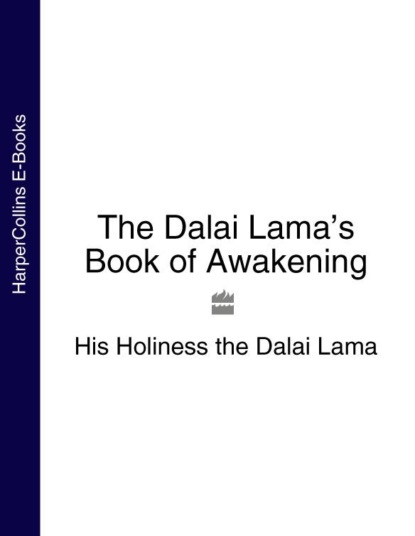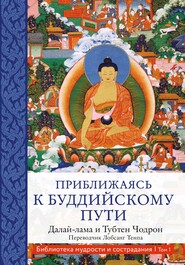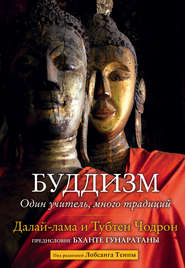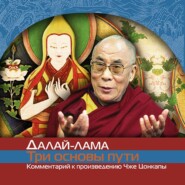По всем вопросам обращайтесь на: info@litportal.ru
(©) 2003-2024.
✖
The Dalai Lama’s Book of Awakening
Автор
Год написания книги
2018
Настройки чтения
Размер шрифта
Высота строк
Поля
So how can we develop a personal understanding of the fundamental Buddhist doctrine of the Two Truths? By coming to know our everyday world of lived experience, we appreciate what is known as samvaharasatya, the world of conventional reality, where the causal principle operates. If we accept the reality of this world as conventional, then we can accept the empty nature of this world which, according to Buddhism, is the ultimate truth, the paramarthasatya. The relationship between these two aspects of reality is important. The world of appearance is used not so much as a contrast or an opposite to the world of ultimate truth, but rather as the evidence, the very basis on which the ultimate nature of reality is established.
Only when you have an understanding of the nature and relationship of these Two Truths are you in a position to fully understand the meaning of the Four Noble Truths. And once you understand the Four Noble Truths, then you have a sound foundation on which to develop a good understanding of what is meant by Taking Refuge in the Three Jewels.
ONE INTRODUCING THE FOUR NOBLE TRUTHS (#ulink_5d2f79fa-f7c5-5754-ab7c-3efc02395e83)
Now let us turn to the Buddhist teaching on the Four Noble Truths. The first question we might ask is why these Truths are considered to be so fundamental, and why, in fact, Buddha taught them at all.
In order to answer this, we have to relate the Four Noble Truths to our own experience as individual human beings. It is a fact – a natural fact of life – that each one of us has an innate desire to seek happiness and to overcome suffering. This is something very instinctive, and there is no need to prove it is there. Happiness is something that we all aspire to achieve, and of course we naturally have a right to fulfill that aspiration. In the same way, suffering is something everybody wishes to avoid, and we also have the right to try to overcome suffering. So if this aspiration to achieve happiness and overcome suffering is our natural state of being, and our natural quest, the question is how we should go about fulfilling that aspiration.
This leads us to the teachings on the Four Noble Truths, which provide an understanding of the relationship between two sets of events: causes and their effects. On one side we have suffering, but suffering does not come from nowhere, it arises as a result of its own causes and conditions. On the other side we have happiness, which also arises from its own particular set of causes and conditions.
Now when we speak of happiness in Buddhism, our understanding of it is not confined to a state of feeling. Certainly cessation (the total cessation of suffering) is not a state of feeling, and yet we could say that cessation is the highest form of happiness because it is, by definition, complete freedom from suffering. Here again cessation, or true happiness, does not come into being from nowhere or without any cause. This is a subtle point, of course, because from the Buddhist perspective cessation is not a conditioned event, so it cannot be said to be actually produced, or caused, by anything. However, the actualization or attainment of cessation does depend on the path and on an individual’s effort. You cannot attain cessation without making an effort. In this sense we can therefore say that the path that leads to cessation is the cause of cessation.
The teachings on the Four Noble Truths clearly distinguish two sets of causes and effects: those causes which produce suffering, and those which produce happiness. By showing us how to distinguish these in our own lives, the teachings aim at nothing less than to enable us to fulfill our deepest aspiration – to be happy and to overcome suffering.
Once we have realized that this is why Buddha taught the Four Noble Truths, we might go on to ask ourselves the reason for their specific sequence: why are the Four Noble Truths taught in a particular order, starting with suffering, continuing with the origin of suffering, and so on? On this point we should understand that the order in which the Four Noble Truths are taught has nothing to do with the order in which things arise in reality. Rather, it is related to the way an individual should go about practicing the Buddhist path, and attain realizations based on that practice.
In the Uttaratantra, Maitreya states that there are four stages to curing an illness.
Just as the disease need be diagnosed, its cause eliminated, a healthy state achieved and the remedy implemented, so also should suffering, its causes, its cessation and the path be known, removed, attained and undertaken.
Maitreya uses the analogy of a sick person to explain the way in which realizations based on the Four Noble Truths can be attained. In order for a sick person to get well, the first step is that he or she must know that he is ill, otherwise the desire to be cured will not arise. Once you have acknowledged that you are sick, then naturally you will try to find out what led to it and what makes your condition even worse. When you have identified these, you will gain an understanding of whether or not the illness can be cured, and a wish to be free from the illness will arise in you. In fact this is not just a mere wish, because once you have recognized the conditions that led to your illness, your desire to be free of it will be much stronger since that knowledge will give you a confidence and conviction that you can overcome the illness. With that conviction, you will want to take all the medications and remedies necessary.
In the same way, unless you know that you are suffering, your desire to be free from suffering will not arise in the first place. So the first step we must take as practicing Buddhists is to recognize our present state as duhkha or suffering, frustration and unsatisfactoriness. Only then will we wish to look into the causes and conditions that give rise to suffering.
It is very important to understand the context of the Buddhist emphasis on recognizing that we are all in a state of suffering, otherwise there is a danger we could misunderstand the Buddhist outlook, and think that it involves rather morbid thinking, a basic pessimism and almost an obsessiveness about the reality of suffering. The reason why Buddha laid so much emphasis on developing insight into the nature of suffering is because there is an alternative – there is a way out, it is actually possible to free oneself from it. This is why it is so crucial to realize the nature of suffering, because the stronger and deeper your insight into suffering is, the stronger your aspiration to gain freedom from it becomes. So the Buddhist emphasis on the nature of suffering should be seen within this wider perspective, where there is an appreciation of the possibility of complete freedom from suffering. If we had no concept of liberation, then to spend so much time reflecting on suffering would be utterly pointless.
We could say that the two sets of causes and effects I mentioned earlier refer, on the one hand, to the process of an unenlightened existence, which relates to the causal chain between suffering and its origins, and, on the other hand, to the process of an enlightened existence which pertains to the causal links between the path and true cessation. When the Buddha elaborated on these two processes, he taught what is called the doctrine of the Twelve Links of Dependent Origination, or Twelve Nidanas.
Вы ознакомились с фрагментом книги.
Приобретайте полный текст книги у нашего партнера:
Приобретайте полный текст книги у нашего партнера:

















